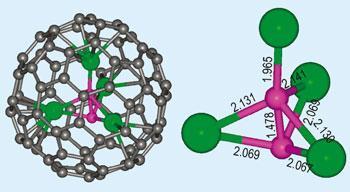Chinese chemists make 'Russian-doll'-style fullerenes, containing three distinct molecules trapped within one another
Chinese chemists have made ’Russian-doll’-style fullerenes, containing three distinct molecules trapped within one another. At the centre is a small C2 species which is nestled inside a tetrahedron of four scandium atoms. This metal cluster is then trapped inside a large C80 ball.
Fullerenes containing different atoms or molecules are termed ’endohedral’ - and the @-symbol is used to distinguish what is trapped inside. This research marks the first time that a three-layer fullerene has been produced: C2@Sc4@C80.
The filled fullerenes were made by a typical arc discharge method, where a large current is passed between two graphite electrodes. This produces a sooty residue containing many fullerenes. By adding scandium to the mix, the team was able to extract small amounts of C2@Sc4@C80 using high-performance liquid chromatography (HPLC).

’According to our spectroscopic and quantum chemical characterisations, the metal cluster rotates freely inside the C80 fullerene cage at room temperature, and the inner C2 species has an unusually high charge state of -6,’ researcher Chun-Ru Wang from the Institute of Chemistry at the Chinese Academy of Sciences told Chemistry World.
These unique properties could lead to many interesting applications, he says, as the rapid rotation of the inner core should behave like a quantum gyroscope. Additionally, the molecule is expected to be super-conducting, and the associated unusual electronic properties may prove promising in designing a molecular capacitor.
Kyriakos Porfyrakis, an expert on endohedral fullerenes at the University of Oxford, UK, is interested by the research. ’Endohedral fullerenes in general have attractive electronic properties. There is potential for photo-physics applications such as photovoltaics, or as MRI contrast agents, particularly if the fullerenes can be made to contain gadolinium atoms.’
One possible advantage of multi-layered fullerenes, Porfyrakis adds, is that it may be possible to use the arrangement of layers to fine-tune the electrical properties - optimising the fullerenes for specific applications.
Since there is still space inside the C80 fullerene, Wang’s team are already working on packing more complicated molecules inside. But the main thing holding this technology back, Porfyrakis says, is the difficulty of producing high quality fullerenes on a large scale. And until this is addressed, fullerenes may struggle to find practical applications.
Lewis Brindley
References
et alJ. Am. Chem. Soc.10.1021/ja9077842






No comments yet